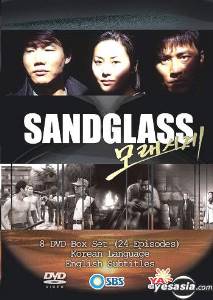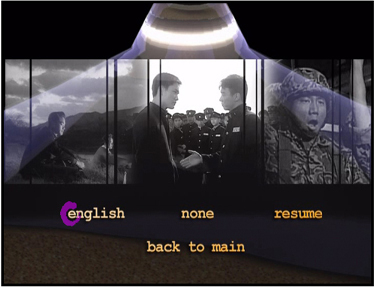CONTEST FOR A FREE EDITION COMPLETED - SEE WINNERS HERE
Sandglass
Directed by Kim Jong Hak
Written by Song Ji Na
Originally aired on SBS Television
January 10 to February 16, 1995
|
|
Thinking of buying from YesAsia? CLICK HERE and use THIS UPDATED BEAVER PAGE to source their very best... |
|
Cast:
Choi Min Soo as Park Tae Soo
Park Sang Won as Kang Woo Suk
Go Hyun Jung as Yoon Hye Rin
Lee Jung Jae as Baek Jae Hee
Park Geun Hyung as Mr. Yoon
Nam Sang Hoon as Do Shik
Jung Sung Mo as Jong Do
Review by Leonard Norwitz
Studio:
Production: SBS (Korea)
Video: YA Entertainment (USA)
Video:
Aspect ratio: 4:3
Region 1: NTSC [check for region 0]
Feature: 480i
Supplements: none
Audio:
Korean DD2.0
Subtitles:
Feature: English
Extras: n/a
Extras:
[None]
Presentation
24 episodes, approx. 50 min. per episode
Extra features: [none]
1 box set with 4 volumes, complete on 8 discs
Release Date: January 3, 2006
Sandglass ~ Comment
(see Introduction to Korean Drama HERE)
Sandglass is essential viewing experience if you want to learn about modern Korean history via a compelling dramatic vehicle instead of the History Channel. It was the most popular drama series of its day, starting off its 24 episode run with a 30% share and averaging an incredible 62% throughout its final ten episodes. Just as important, Sandglass is a fabulous, near faultless series: the story, screenplay (even in translation), direction and acting are all first rate. The only thing I can find wanting is the kind of highly textured production values we have become used to in American television over the last decade or two. But, given the epic sweep of the story, the level of acting and the seriousness of the screenplay, in that it pulls no political or dramatic punches, we scarcely miss it.
Sandglass is certainly one of the most important adult dramas to come out of Korea up to this moment – this despite (or because) that the love story is secondary to its politically charged subject, though it becomes an important emotional force in the later episodes. I say “political” though little of the story takes places in the halls of government as such. Sandglass is no fairy tale and avoids low comedy, with none of the goofy best friends that infest Korean romances. Most of the time, Sandglass is straight drama with large dollops of violence: 1-on-1, gang fights, and military and paramilitary skirmishes - all far more realistically staged than we see in some of the more recent historical Korean television outings, such as Jumong. You might be surprised at little gunfire there is outside the military operations.
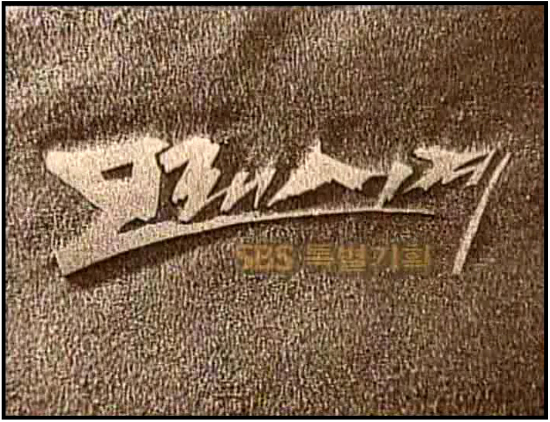 |
At just over twenty hours, Sandglass is longer and more epic in scope than your usual 16-part drama series, yet it never feels like time is standing still just in order to give the sponsors an opportunity to make more money at the expense of the story. We know that things will end by the 24th episode, but we never want the drama to "wrap it up."
It may be of interest that Sandglass is the result of the same collaboration that created Eyes of Dawn, the1992 series that many consider the start of modern Korean television dramas [available HERE]. Producer Kim Jong Ha and writer Song Ji Na moved from the then number one network, MBC, to fledgling SBS to work on Sandglass. It is not uncommon for women to write screenplays for Korean dramas since women comprise the largest part of the television watching audience, but clearly both Eyes of Dawn and Sandglass were targeted to a much wider audience and Ms. Song is fully up to the challenge. There is plenty of toughness to match its realistic and intense romantic passions.
As for the direction supplied by Kim Jong Hak, Sandglass is a demonstration vehicle for the kind of direct, yet subtle expression of emotion that is typical of Korean drama at its best and so atypical of American TV fare. The extended scene when Tae Soo's mother speaks to him for the first time about his father is telling in this regard: Tae Soo sits silently, still in his school uniform after hearing about his father's communist past from the college admissions authorities, while his mother reminisces about her husband, whose wedding ring she still wears. She is the only one who speaks. Her tone is gradually filled with regret – not only for the loss of her husband, but for the loss of Tae Soo's future, for she knows the world will never accommodate to his good intentions. Though apparently impassive, it is evident that Tae Soo respects and loves his mother deeply. He makes no protestations, no gestures of sympathy, as would have to be expressed in a Western drama at this point. This moment gives way to a scene with Tae Soo's mother alone on a mountain overlook. She has been drinking. She looks both sorrowful and perhaps resolute. Next, a train station: it is a ferociously windy day. Her scarf blows onto the track. She goes to pick it up and observes the train approaching the station. She considers the possibilities, as if for the first time. The camera cuts to the train wheels passing over the scarf, which is then seeing floating up to the sky, dissolving into the casket as it approaches the flames. Tae Soo is in his traditional funeral garments, forcefully held back by friends from entering the pyre with her. Cut to Tae Soo scattering her ashes from that same mountain overlook. He now has the wedding ring on his hand. From the moment his mother finishes her story, there is no dialogue – only the music, previously enough in the background as to not be noticed, now our emotional guide from scene to scene. The entire incident is intense and powerful, extraordinarily touching – and represents Korean drama at its best.
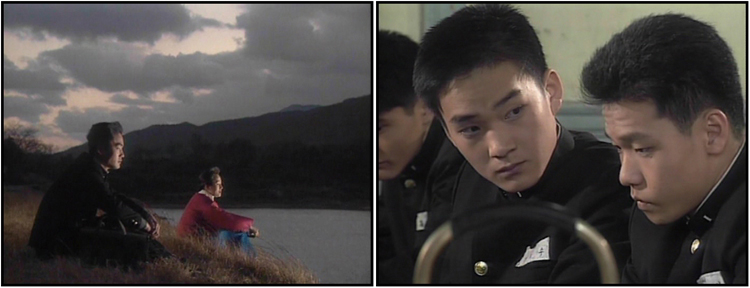 |
If you ever want to read deep background about Korean television dramas, you would find no better on-line resource than the news and review magazine, Twitch. Whether or not you or I agree with his conclusions, the writer known as "X" seems to really know his stuff. In his review of Sandglass HERE X points out that SBS settled on three relatively young or inexperienced talents in major roles, but kept veteran actors as supporting characters – a sensible solution if you plan to attract a new audience while keeping the faith. The charisma of these younger actors (only one of which, Choi Min Soo, has maintained a presence on film and TV before and since) keeps Westerners engaged through some fairly thick political pea soup, much of which is taken for granted by its intended audience. Since there are no extra features for this DVD set to help us out, our comprehension of events is dependent on Kim Jong Hak's direction and the translation of dialog (which is this case is adequate, but not revelatory). His actors convey plenty enough meaning without overdoing the emotional angst, without which what Korean drama would find its way into the hearts and minds of its viewers?
The importance of the historical context of the events depicted in the drama and the televising of the series cannot be overstated. Sandglass had far-reaching political ramifications as its story targeted political corruption all the way to the presidency, reflecting popular feeling about the administration of then president Park Chung-hee. As it happened, the release of Sandglass was timed with the 50th anniversary of Korean emancipation from Japan in 1945 – a year, by the way, that also saw the invasion of Manchuria by Soviet Russia soon after the Allied bombing of Hiroshima and their subsequent occupation of what became North Korea. Governments friendly to the USSR and to the USA were set up in North and South Korea respectively as early as September, which, in turn, led directly to the Korean War. Much of the fifty years that passed since the division of Korea by the Allied powers was dominated by the Park government. A generation of Koreans, still living, suffered through his oppressive rule from 1961 to 1979 and the following "reformation" that led to the 1980 Gwangju Massacre. As much out of habit as anything else, Koreans, even in the South, did not speak openly about those days nor even about reunification until dramas like Eyes of Dawn and Sandglass opened a Pandora's Box. It has only been since then that films such as A Single Spark, JSA: Joint Security Area and The President's Last Bang could find their way into the mainstream.
 |
Sandglass puts me in mind of Francis Coppola's The Godfather, Part 2. It has a similar tone and reach from youth to adult for all three of its main protagonists. Both stories involve the politics of corruption and its impact on a family whose business is casinos. Some of the music is evocative of the Coppola movie, as well. Just listen to the opening of Episode 3: Rip-off, no. Homage, certainly. It is, then, no exaggeration, to say that Sandglass is Korea's Godfather. To watch this series to its end is to find your way into the heart and soul of this tortured country.
Sandglass
The Score Card
The Series : 10
The saga of political turmoil in modern Korea (late 1960s through the 1980s) is seen through three fictional characters: Park Tae Soo is a young middle management, charismatic gangster for one of the more “connected” families; Kang Woo Suk is Tae Soo’s high school friend, now an incorruptible prosecutor for the government. Between them is Yoon Hye Rin, who was introduced to Tae Soo by Woo Suk during his days in law school. Hye Rin is the daughter of the president of the company that fronts Tae Soo’s operations. For personal and social reasons she is estranged from her father.
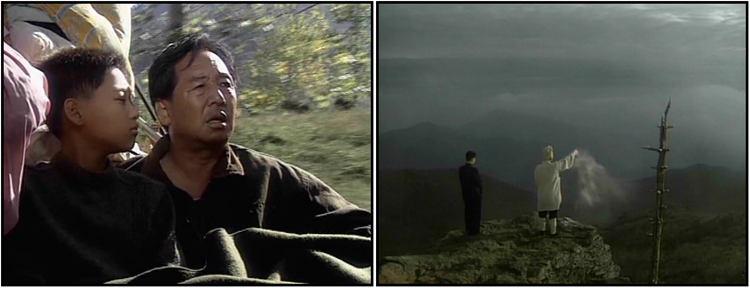 |
Through layered flashbacks over the first three episodes, we follow each of the main characters from key moments in their respective childhoods. Tae Soo transfers to a school in Gwangju where he soon demonstrates his fearless fighting skills. While being courted by gangs and local politicians alike, he befriends the local bookworm, Woo Suk, an ace student. Tae Soo is so drawn to the uncompromising ethics of Woo Suk that he promises to fight no more. It's a brief courtship. Unhappily, the door to Tae Soo's future as a student is slammed shut when he learns from the college he applies to that his long-deceased father was a communist sympathizer. The subsequent suicide by his mother gets him back on track as the gangster we all knew he would become.
Woo Suk keeps his eye on the ball all the way through law school, scarcely aware of radical student movements that threaten to unhinge the repressive national government. But he has enough of the young man left over to be impressed with the brash Hye Rin, who works on an activist student newspaper. When Woo Suk meets up with Tae Soo after some years' separation, he tells him, only half-jokingly, that someday he might have to prosecute him. A fateful love triangle develops with Hye Rin between them, as does their eventual confrontation on opposite sides of the law – complicated by Hye Rin's later involvement in the family casino business.
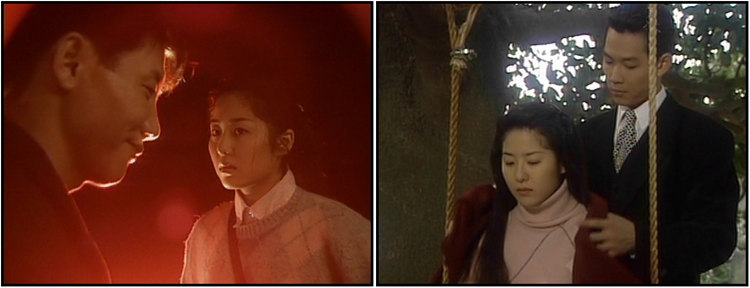 |
Edition: 7
The unsubtitled Bitwin R3 edition has a more solid image. It is marginally sharper, with fewer artifacts and a little less edge enhancement. The contrast is always in better control, with night shots rarely artificially brightened. The audio is also a skosh more dynamic as well on the Bitwin. As a result, the drama is easier on the eyes and brain and we are necessarily more engaged. The Bitwin box, however, is flimsy and the discs difficult to access. It is likely that the YAE edition is as good an English subtitled edition as we will ever see of this fine series.
Image : 6 (4~5.5/7)
The score of 6 indicates a relative level of excellence compared to other standard definition DVDs on a 10-point scale for SD DVDs. The score in parentheses represents: first, a value for the image on a 10-point scale that accommodates both standard and high-definition DVDs – where any score above 7 for an SD is outstanding, since the large majority of high definition DVDs are 8-9.5. The second number in parentheses indicates how that image compares to what we might have seen as first shown on television, in this case, standard definition.
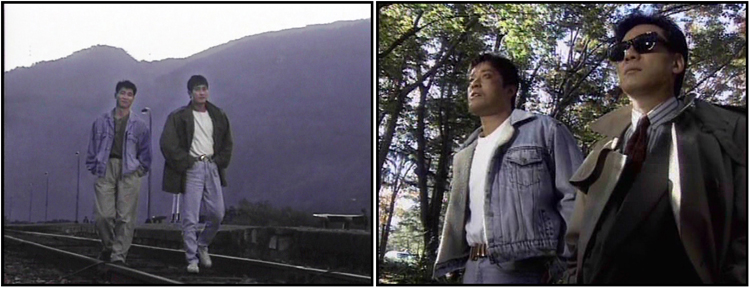 |
Sharpness is not a major problem, but overall, the image and color saturation is thin – more so in some places than others. Night scenes are a little brightened, adding as much noise as information. These discrepancies are observable off and on throughout the series, more so in first couple of episodes. Combing and some edge enhancement is also present. There is also a minor, but curious error in regards aspect ratio: For some reason, the images under the credits are actually 16x9, but squeezed into a 4:3 format. Your player will likely not recognize it as anamorphic, but if your display can force the image into a 16x9 image, the result is perfect. Why this portion of the show should be widescreen in the first place passes understanding, but adding error to irregularity, how could it not be noticed that everyone looks like they spent a year in a vice? The same mistake, by the way, occurs in the Bitwin edition.
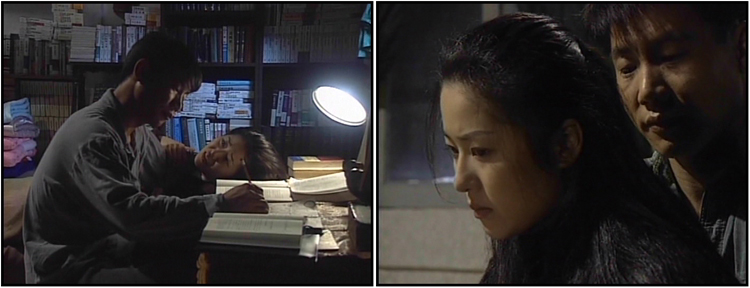 |
Audio & Music : 6/8
There is something curiously Russian or Slavic about the music for this series. I can’t help but conjure images from Doctor Zhivago, though the music isn’t Maurice Jarre by a long shot. It all sounds familiar, brooding, mythic. It’s too bad the composer/arranger had neither the time nor the inclination to arrange the musical interludes with some variety so instead, each time a theme appears it is presented in the same way. Even moving melodies can become tiresome after a while. On the credit side, as is usual with Korean TV dramas, the dialogue is recorded live rather than looped later, permitting a direct and intimate experience with the actors not so common on much of prime time American television. The audio effects are fair to good - the most problematic being the lack of plausible variety to the various punches, kicks, and falls during a fight. On the other hand, there is a documentary feel to the lengthy rebellion and massacre in Gwangju that could hardly have been more palpable.
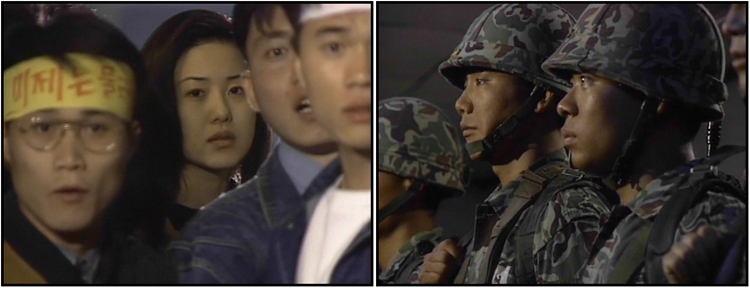 |
Translation & Subtitles : 6
Considering this is an early effort for Korean television dramas, the translation is generally fairly good in terms of its being in recognizable idiomatic English and representative of each different character. There are some instances where the translation is cumbersome or unclear, however. It’s not all that easy to distinguish between some of the supporting characters referred to as “president” and little else. Koreans would have no trouble with this, I imagine, but without some awareness of the context, it was sometimes difficult for the likes of me.
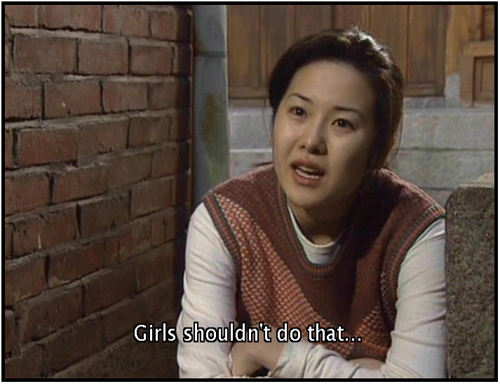 |
Operations & Box Design : 8/5
Menu functions are simple enough, since there is little need for elaboration, but the box is insubstantial, opening to two sturdy, but clunky inner volumes, each with 4 discs.
Extras : 0
A commentary (which do not exist for any Korean drama as yet in either Korean or English), or a synopsis as part of the extra features, or a booklet about modern Korean history would have been handy.
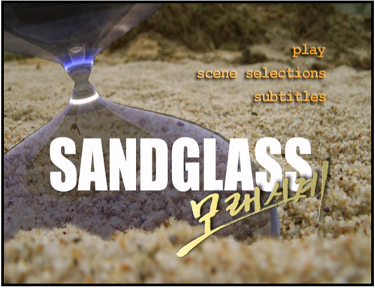 |
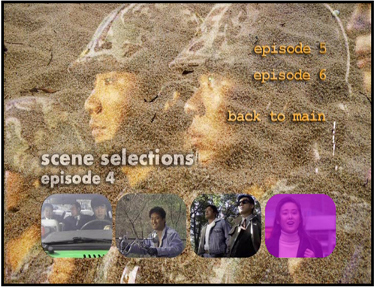 |
|
|
|
Recommendation: 9
Highly recommended, despite the less than ideal image and the absence of Extra Features.
Leonard Norwitz
LensViews
January 23rd, 2008
|
|
Thinking of buying from YesAsia? CLICK HERE and use THIS UPDATED BEAVER PAGE to source their very best... |
WINNER OF COMPLETE SERIES
: Nick Shelton
Baldwinsville, NY
And here's our runners-up for a sampler:
•Steve B.
Durham, NC
• Gregory E.
Columbus, OH
• Troy W.
Moorhead, MN
• Paul K.
Schenectady, NY
• Sam Z.
Sharon, MA
• Gil L.
Sacramento, CA
GOOD LUCK ALL!

